Managing People in the Organization: A Comprehensive Management Report
VerifiedAdded on 2023/06/18
|16
|3613
|465
Report
AI Summary
This report provides a comprehensive overview of managing people within an organization, covering essential aspects such as recruitment methods, job descriptions, and interview best practices. It delves into performance management processes, emphasizing the importance of setting standards and providing feedback. Furthermore, the report compares training, coaching, counseling, and mentoring, while also exploring the learning cycle and psychometric tests. Effective training strategies, including needs assessment and objective setting, are discussed in detail. The report also reviews personal effectiveness, including preferred learning styles, behavioral aspects, goal setting, and time management skills. Finally, it addresses workplace welfare, health and safety duties, and change management within organizations. This document is available on Desklib, a platform offering a wealth of study tools and solved assignments for students.
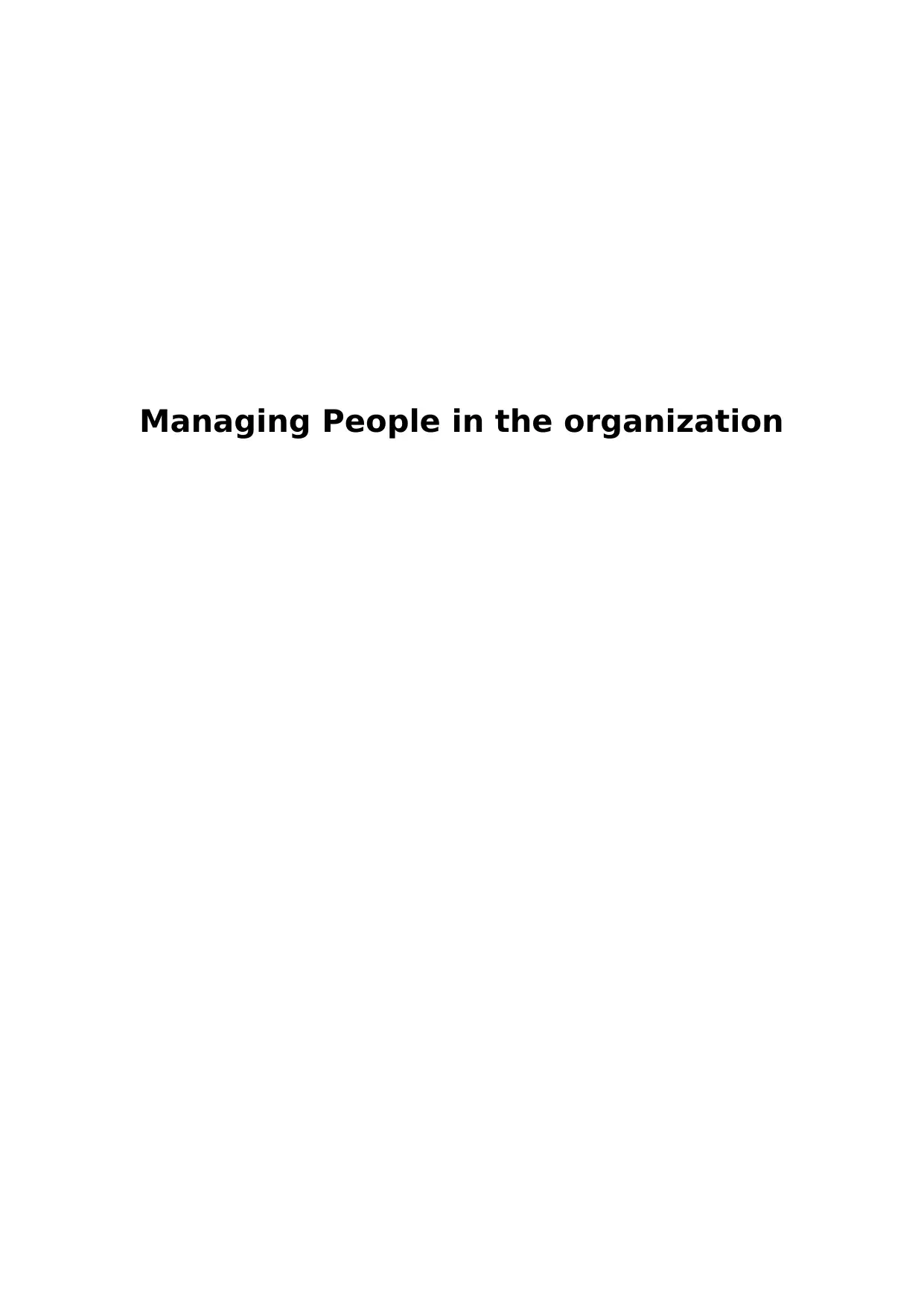
Managing People in the organization
Paraphrase This Document
Need a fresh take? Get an instant paraphrase of this document with our AI Paraphraser
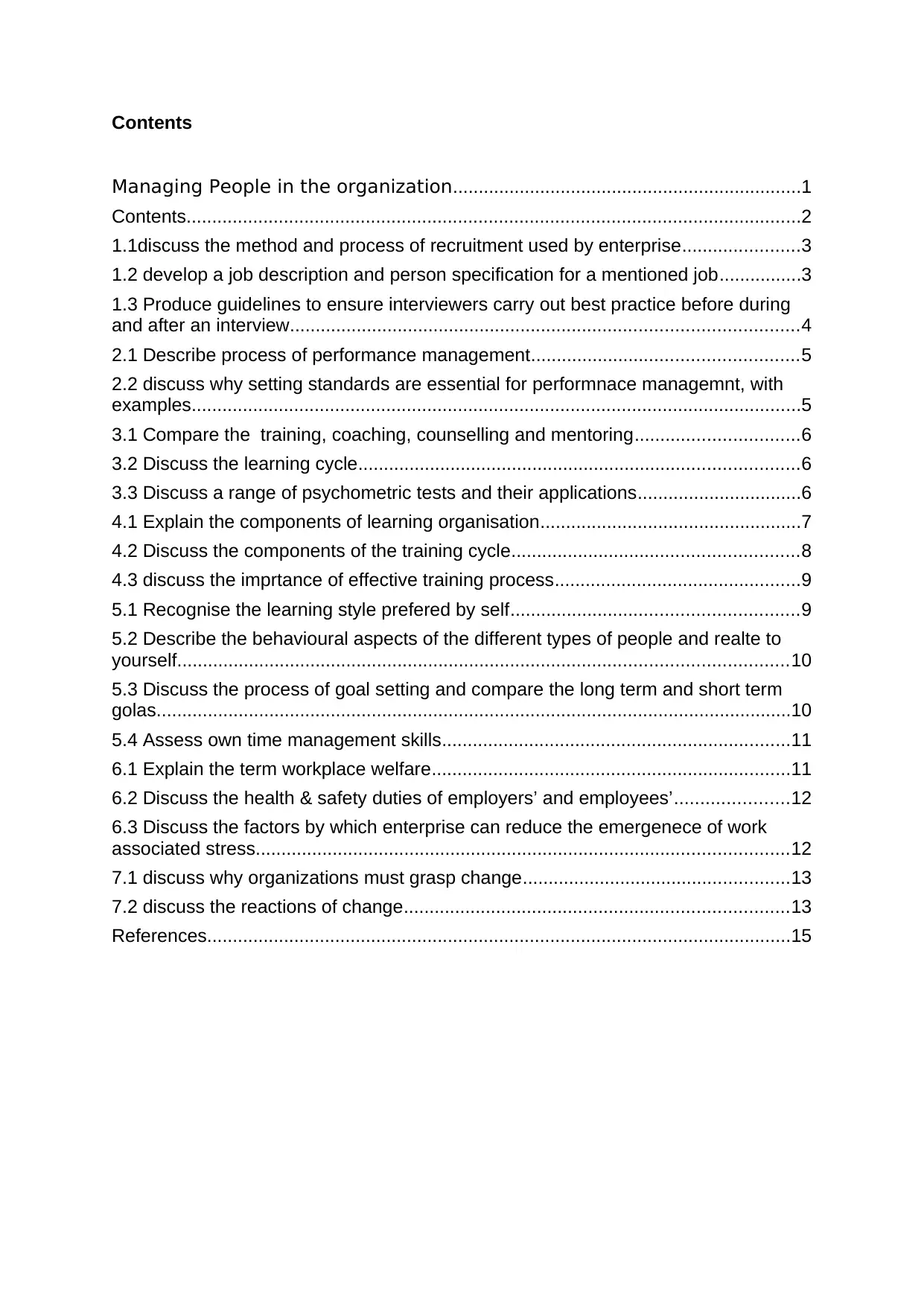
Contents
Managing People in the organization....................................................................1
Contents........................................................................................................................2
1.1discuss the method and process of recruitment used by enterprise.......................3
1.2 develop a job description and person specification for a mentioned job................3
1.3 Produce guidelines to ensure interviewers carry out best practice before during
and after an interview...................................................................................................4
2.1 Describe process of performance management....................................................5
2.2 discuss why setting standards are essential for performnace managemnt, with
examples.......................................................................................................................5
3.1 Compare the training, coaching, counselling and mentoring................................6
3.2 Discuss the learning cycle......................................................................................6
3.3 Discuss a range of psychometric tests and their applications................................6
4.1 Explain the components of learning organisation...................................................7
4.2 Discuss the components of the training cycle........................................................8
4.3 discuss the imprtance of effective training process................................................9
5.1 Recognise the learning style prefered by self........................................................9
5.2 Describe the behavioural aspects of the different types of people and realte to
yourself.......................................................................................................................10
5.3 Discuss the process of goal setting and compare the long term and short term
golas............................................................................................................................10
5.4 Assess own time management skills....................................................................11
6.1 Explain the term workplace welfare......................................................................11
6.2 Discuss the health & safety duties of employers’ and employees’......................12
6.3 Discuss the factors by which enterprise can reduce the emergenece of work
associated stress........................................................................................................12
7.1 discuss why organizations must grasp change....................................................13
7.2 discuss the reactions of change...........................................................................13
References..................................................................................................................15
Managing People in the organization....................................................................1
Contents........................................................................................................................2
1.1discuss the method and process of recruitment used by enterprise.......................3
1.2 develop a job description and person specification for a mentioned job................3
1.3 Produce guidelines to ensure interviewers carry out best practice before during
and after an interview...................................................................................................4
2.1 Describe process of performance management....................................................5
2.2 discuss why setting standards are essential for performnace managemnt, with
examples.......................................................................................................................5
3.1 Compare the training, coaching, counselling and mentoring................................6
3.2 Discuss the learning cycle......................................................................................6
3.3 Discuss a range of psychometric tests and their applications................................6
4.1 Explain the components of learning organisation...................................................7
4.2 Discuss the components of the training cycle........................................................8
4.3 discuss the imprtance of effective training process................................................9
5.1 Recognise the learning style prefered by self........................................................9
5.2 Describe the behavioural aspects of the different types of people and realte to
yourself.......................................................................................................................10
5.3 Discuss the process of goal setting and compare the long term and short term
golas............................................................................................................................10
5.4 Assess own time management skills....................................................................11
6.1 Explain the term workplace welfare......................................................................11
6.2 Discuss the health & safety duties of employers’ and employees’......................12
6.3 Discuss the factors by which enterprise can reduce the emergenece of work
associated stress........................................................................................................12
7.1 discuss why organizations must grasp change....................................................13
7.2 discuss the reactions of change...........................................................................13
References..................................................................................................................15

1.1discuss the method and process of recruitment used by enterprise
Recruitment is defined as a procedure of hunting and attracting potential
resources for consuming up vacant positions in an enterprise.
Recruitment Planning
Planning involves crafting a complete job specification for the available position,
mentioning the responsibilities, the abilities and qualifications required.
Searching
In the searching process, invitation and the job opening notification are sent to
various direct and indirect sources depending on the requirement of the job profile.
Recruitment methods
Different methods of recruitment are mentioned below:
- Direct method
The direct method involves assigning recruiters to professional institutions directly for
college placements. Most college recruiting is done in coordination with the
placement authority of the college or university.
- Indirect method
The most widely used indirect method of renting an ad in newspapers, journals, and
radio, and television. It enables the organization to reach a large audience.
1.2 develop a job description and person specification for a mentioned job
A job description mentions the key duties and expected competencies of a job.
- The job title of the vacant position
- The location of the job. If rotational, has to be mentioned
- Job salary and allowances
Personal specification
This incorporates the profile of the personal knowledge, skills, qualifications and
experiences.
Recruitment is defined as a procedure of hunting and attracting potential
resources for consuming up vacant positions in an enterprise.
Recruitment Planning
Planning involves crafting a complete job specification for the available position,
mentioning the responsibilities, the abilities and qualifications required.
Searching
In the searching process, invitation and the job opening notification are sent to
various direct and indirect sources depending on the requirement of the job profile.
Recruitment methods
Different methods of recruitment are mentioned below:
- Direct method
The direct method involves assigning recruiters to professional institutions directly for
college placements. Most college recruiting is done in coordination with the
placement authority of the college or university.
- Indirect method
The most widely used indirect method of renting an ad in newspapers, journals, and
radio, and television. It enables the organization to reach a large audience.
1.2 develop a job description and person specification for a mentioned job
A job description mentions the key duties and expected competencies of a job.
- The job title of the vacant position
- The location of the job. If rotational, has to be mentioned
- Job salary and allowances
Personal specification
This incorporates the profile of the personal knowledge, skills, qualifications and
experiences.
⊘ This is a preview!⊘
Do you want full access?
Subscribe today to unlock all pages.

Trusted by 1+ million students worldwide
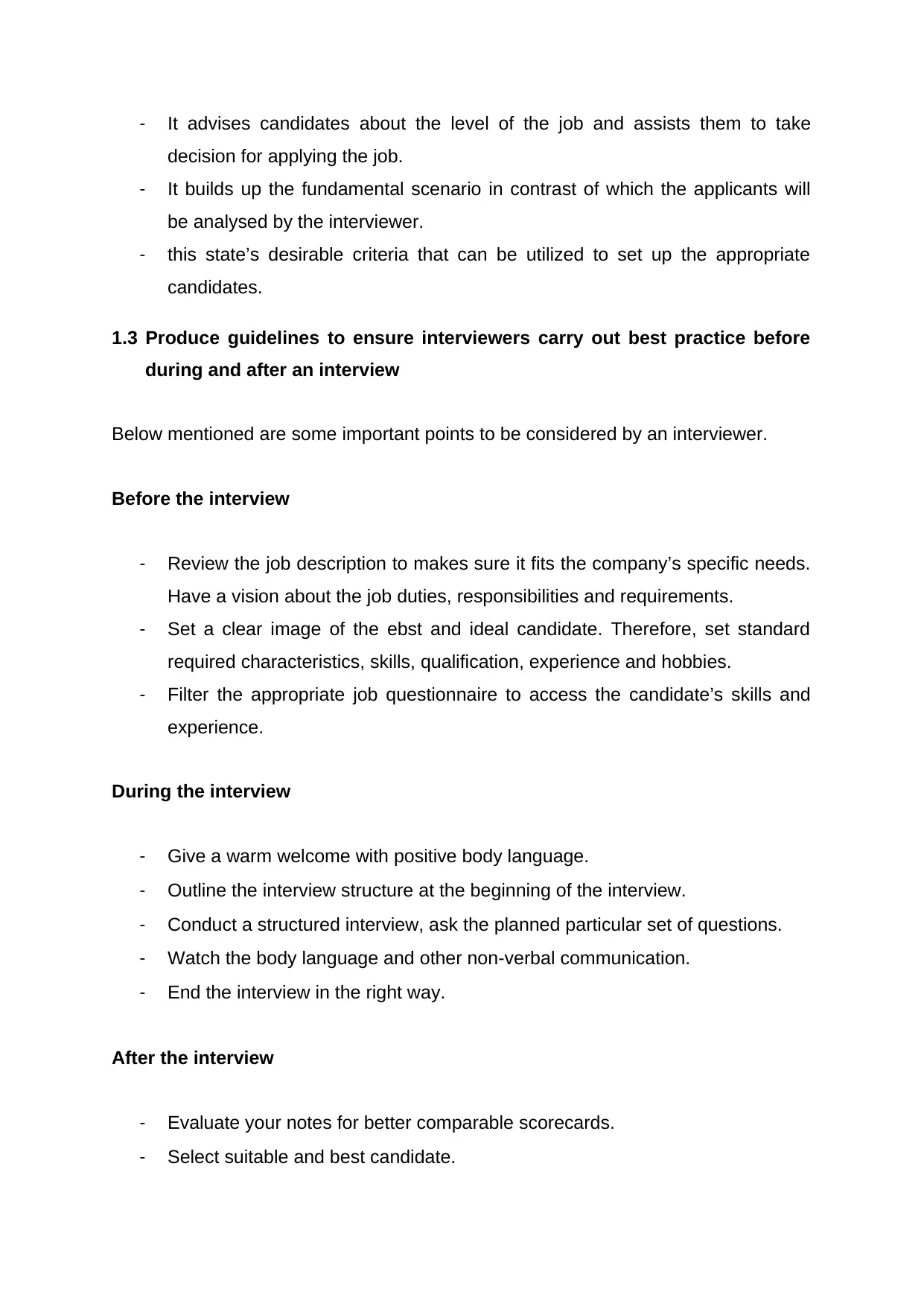
- It advises candidates about the level of the job and assists them to take
decision for applying the job.
- It builds up the fundamental scenario in contrast of which the applicants will
be analysed by the interviewer.
- this state’s desirable criteria that can be utilized to set up the appropriate
candidates.
1.3 Produce guidelines to ensure interviewers carry out best practice before
during and after an interview
Below mentioned are some important points to be considered by an interviewer.
Before the interview
- Review the job description to makes sure it fits the company’s specific needs.
Have a vision about the job duties, responsibilities and requirements.
- Set a clear image of the ebst and ideal candidate. Therefore, set standard
required characteristics, skills, qualification, experience and hobbies.
- Filter the appropriate job questionnaire to access the candidate’s skills and
experience.
During the interview
- Give a warm welcome with positive body language.
- Outline the interview structure at the beginning of the interview.
- Conduct a structured interview, ask the planned particular set of questions.
- Watch the body language and other non-verbal communication.
- End the interview in the right way.
After the interview
- Evaluate your notes for better comparable scorecards.
- Select suitable and best candidate.
decision for applying the job.
- It builds up the fundamental scenario in contrast of which the applicants will
be analysed by the interviewer.
- this state’s desirable criteria that can be utilized to set up the appropriate
candidates.
1.3 Produce guidelines to ensure interviewers carry out best practice before
during and after an interview
Below mentioned are some important points to be considered by an interviewer.
Before the interview
- Review the job description to makes sure it fits the company’s specific needs.
Have a vision about the job duties, responsibilities and requirements.
- Set a clear image of the ebst and ideal candidate. Therefore, set standard
required characteristics, skills, qualification, experience and hobbies.
- Filter the appropriate job questionnaire to access the candidate’s skills and
experience.
During the interview
- Give a warm welcome with positive body language.
- Outline the interview structure at the beginning of the interview.
- Conduct a structured interview, ask the planned particular set of questions.
- Watch the body language and other non-verbal communication.
- End the interview in the right way.
After the interview
- Evaluate your notes for better comparable scorecards.
- Select suitable and best candidate.
Paraphrase This Document
Need a fresh take? Get an instant paraphrase of this document with our AI Paraphraser
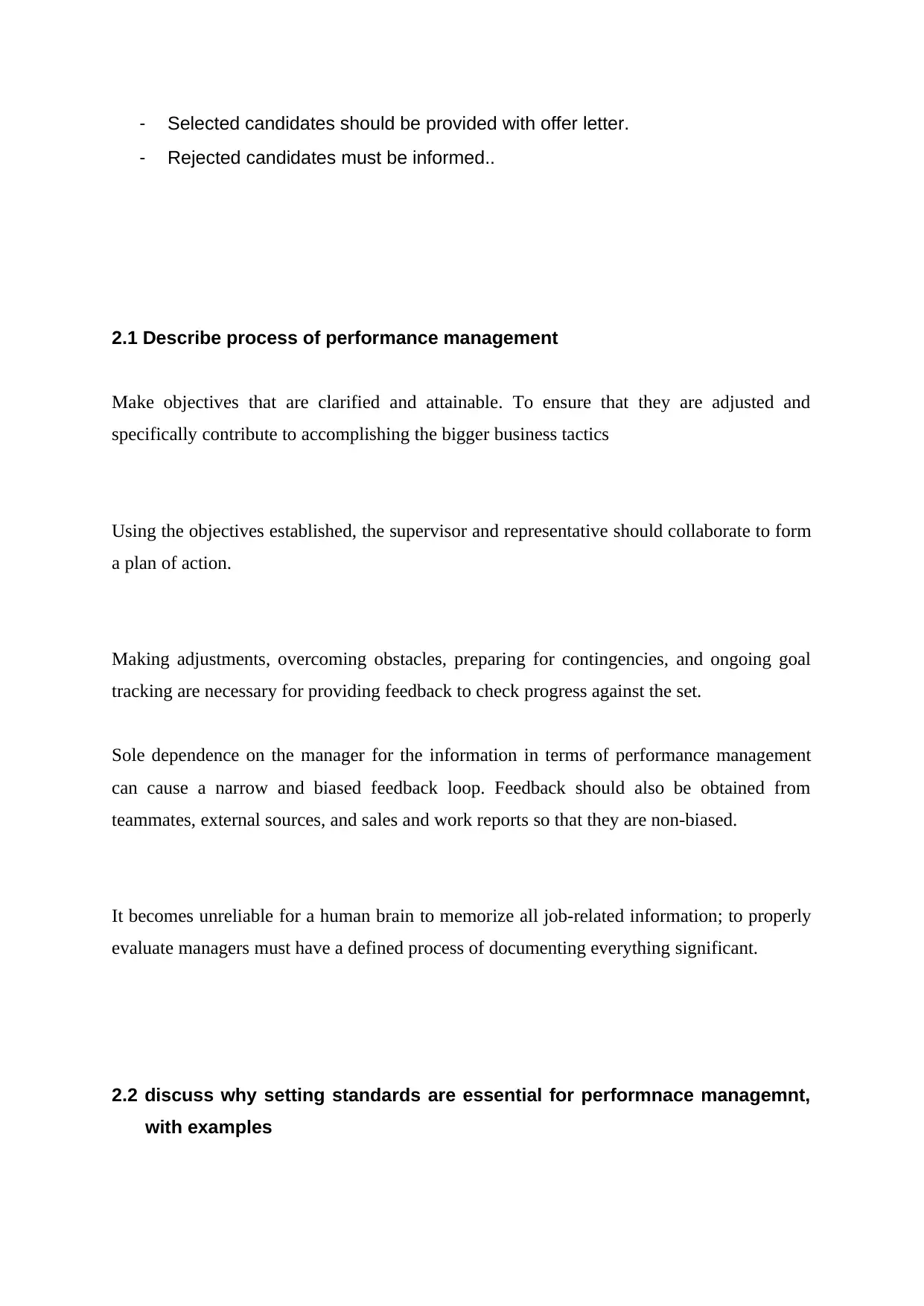
- Selected candidates should be provided with offer letter.
- Rejected candidates must be informed..
2.1 Describe process of performance management
Make objectives that are clarified and attainable. To ensure that they are adjusted and
specifically contribute to accomplishing the bigger business tactics
Using the objectives established, the supervisor and representative should collaborate to form
a plan of action.
Making adjustments, overcoming obstacles, preparing for contingencies, and ongoing goal
tracking are necessary for providing feedback to check progress against the set.
Sole dependence on the manager for the information in terms of performance management
can cause a narrow and biased feedback loop. Feedback should also be obtained from
teammates, external sources, and sales and work reports so that they are non-biased.
It becomes unreliable for a human brain to memorize all job-related information; to properly
evaluate managers must have a defined process of documenting everything significant.
2.2 discuss why setting standards are essential for performnace managemnt,
with examples
- Rejected candidates must be informed..
2.1 Describe process of performance management
Make objectives that are clarified and attainable. To ensure that they are adjusted and
specifically contribute to accomplishing the bigger business tactics
Using the objectives established, the supervisor and representative should collaborate to form
a plan of action.
Making adjustments, overcoming obstacles, preparing for contingencies, and ongoing goal
tracking are necessary for providing feedback to check progress against the set.
Sole dependence on the manager for the information in terms of performance management
can cause a narrow and biased feedback loop. Feedback should also be obtained from
teammates, external sources, and sales and work reports so that they are non-biased.
It becomes unreliable for a human brain to memorize all job-related information; to properly
evaluate managers must have a defined process of documenting everything significant.
2.2 discuss why setting standards are essential for performnace managemnt,
with examples
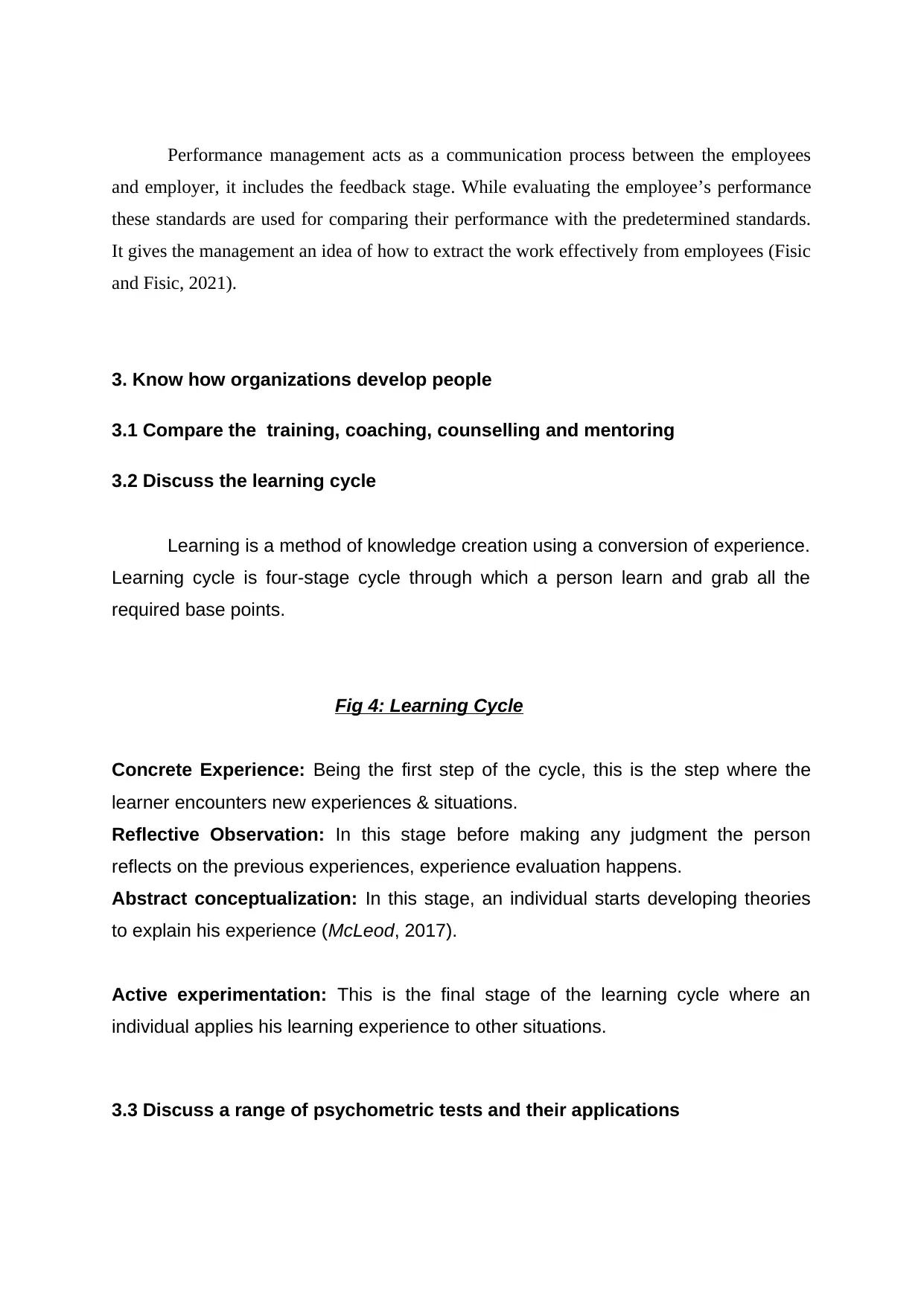
Performance management acts as a communication process between the employees
and employer, it includes the feedback stage. While evaluating the employee’s performance
these standards are used for comparing their performance with the predetermined standards.
It gives the management an idea of how to extract the work effectively from employees (Fisic
and Fisic, 2021).
3. Know how organizations develop people
3.1 Compare the training, coaching, counselling and mentoring
3.2 Discuss the learning cycle
Learning is a method of knowledge creation using a conversion of experience.
Learning cycle is four-stage cycle through which a person learn and grab all the
required base points.
Fig 4: Learning Cycle
Concrete Experience: Being the first step of the cycle, this is the step where the
learner encounters new experiences & situations.
Reflective Observation: In this stage before making any judgment the person
reflects on the previous experiences, experience evaluation happens.
Abstract conceptualization: In this stage, an individual starts developing theories
to explain his experience (McLeod, 2017).
Active experimentation: This is the final stage of the learning cycle where an
individual applies his learning experience to other situations.
3.3 Discuss a range of psychometric tests and their applications
and employer, it includes the feedback stage. While evaluating the employee’s performance
these standards are used for comparing their performance with the predetermined standards.
It gives the management an idea of how to extract the work effectively from employees (Fisic
and Fisic, 2021).
3. Know how organizations develop people
3.1 Compare the training, coaching, counselling and mentoring
3.2 Discuss the learning cycle
Learning is a method of knowledge creation using a conversion of experience.
Learning cycle is four-stage cycle through which a person learn and grab all the
required base points.
Fig 4: Learning Cycle
Concrete Experience: Being the first step of the cycle, this is the step where the
learner encounters new experiences & situations.
Reflective Observation: In this stage before making any judgment the person
reflects on the previous experiences, experience evaluation happens.
Abstract conceptualization: In this stage, an individual starts developing theories
to explain his experience (McLeod, 2017).
Active experimentation: This is the final stage of the learning cycle where an
individual applies his learning experience to other situations.
3.3 Discuss a range of psychometric tests and their applications
⊘ This is a preview!⊘
Do you want full access?
Subscribe today to unlock all pages.

Trusted by 1+ million students worldwide
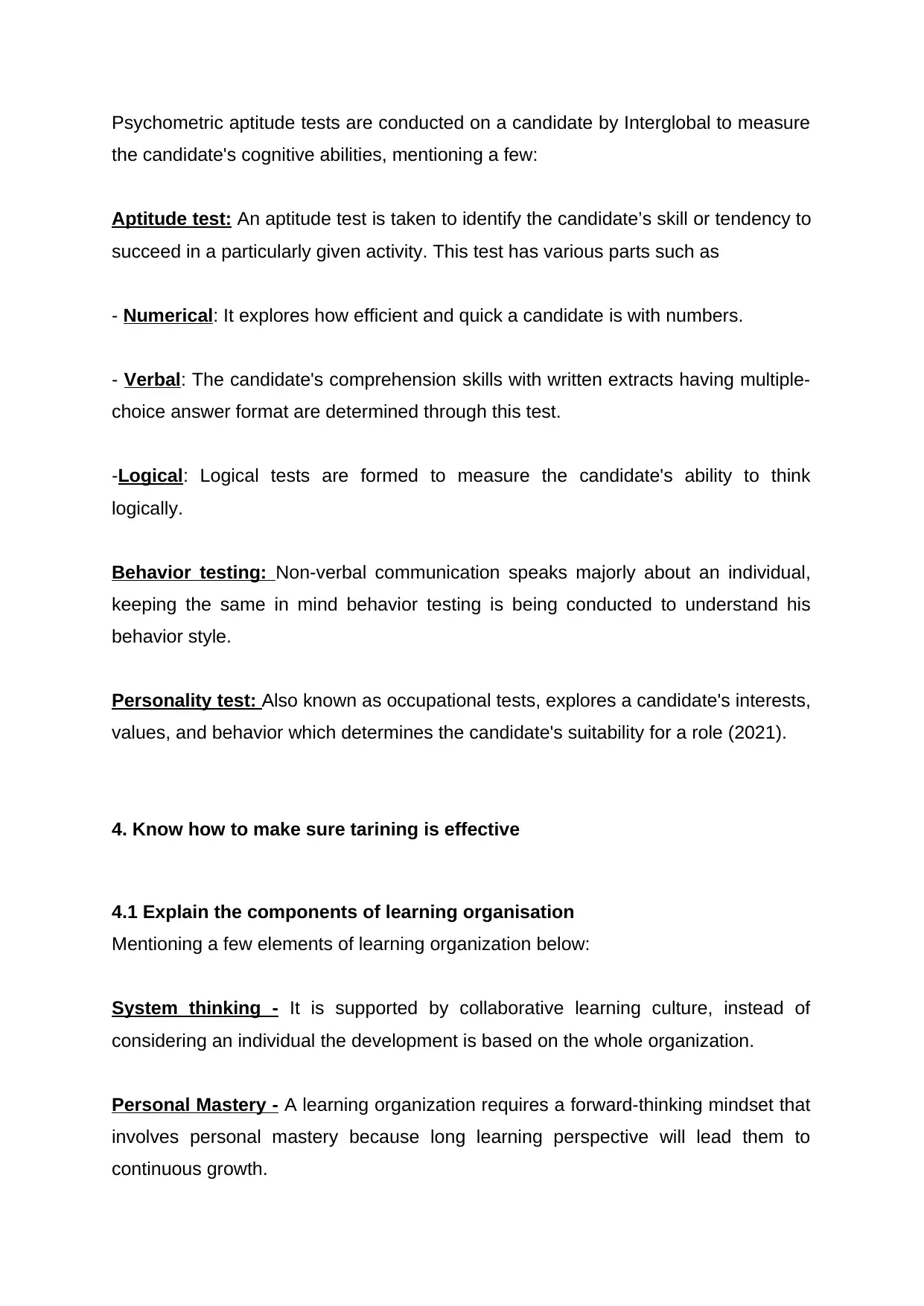
Psychometric aptitude tests are conducted on a candidate by Interglobal to measure
the candidate's cognitive abilities, mentioning a few:
Aptitude test: An aptitude test is taken to identify the candidate’s skill or tendency to
succeed in a particularly given activity. This test has various parts such as
- Numerical: It explores how efficient and quick a candidate is with numbers.
- Verbal: The candidate's comprehension skills with written extracts having multiple-
choice answer format are determined through this test.
-Logical: Logical tests are formed to measure the candidate's ability to think
logically.
Behavior testing: Non-verbal communication speaks majorly about an individual,
keeping the same in mind behavior testing is being conducted to understand his
behavior style.
Personality test: Also known as occupational tests, explores a candidate's interests,
values, and behavior which determines the candidate's suitability for a role (2021).
4. Know how to make sure tarining is effective
4.1 Explain the components of learning organisation
Mentioning a few elements of learning organization below:
System thinking - It is supported by collaborative learning culture, instead of
considering an individual the development is based on the whole organization.
Personal Mastery - A learning organization requires a forward-thinking mindset that
involves personal mastery because long learning perspective will lead them to
continuous growth.
the candidate's cognitive abilities, mentioning a few:
Aptitude test: An aptitude test is taken to identify the candidate’s skill or tendency to
succeed in a particularly given activity. This test has various parts such as
- Numerical: It explores how efficient and quick a candidate is with numbers.
- Verbal: The candidate's comprehension skills with written extracts having multiple-
choice answer format are determined through this test.
-Logical: Logical tests are formed to measure the candidate's ability to think
logically.
Behavior testing: Non-verbal communication speaks majorly about an individual,
keeping the same in mind behavior testing is being conducted to understand his
behavior style.
Personality test: Also known as occupational tests, explores a candidate's interests,
values, and behavior which determines the candidate's suitability for a role (2021).
4. Know how to make sure tarining is effective
4.1 Explain the components of learning organisation
Mentioning a few elements of learning organization below:
System thinking - It is supported by collaborative learning culture, instead of
considering an individual the development is based on the whole organization.
Personal Mastery - A learning organization requires a forward-thinking mindset that
involves personal mastery because long learning perspective will lead them to
continuous growth.
Paraphrase This Document
Need a fresh take? Get an instant paraphrase of this document with our AI Paraphraser
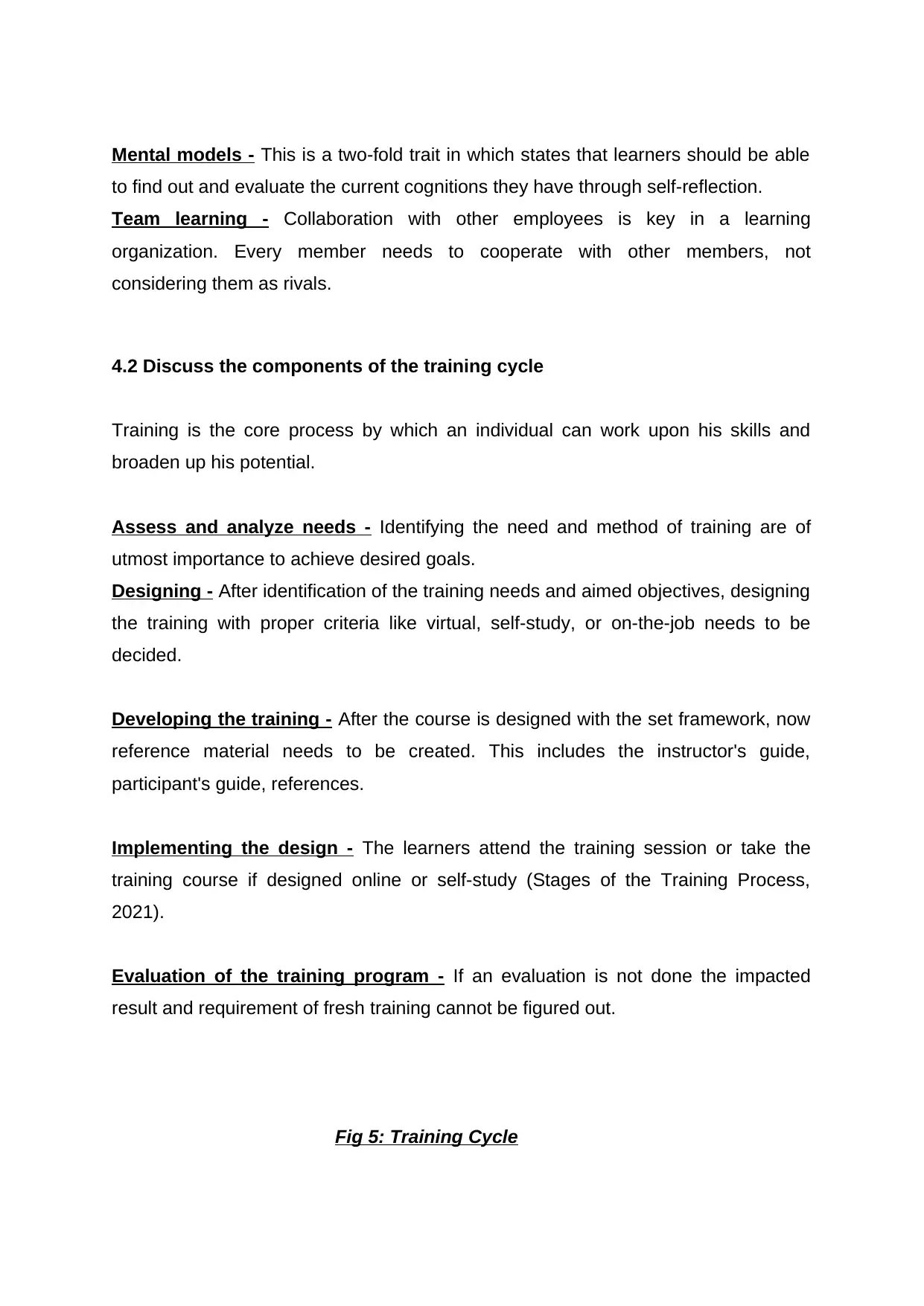
Mental models - This is a two-fold trait in which states that learners should be able
to find out and evaluate the current cognitions they have through self-reflection.
Team learning - Collaboration with other employees is key in a learning
organization. Every member needs to cooperate with other members, not
considering them as rivals.
4.2 Discuss the components of the training cycle
Training is the core process by which an individual can work upon his skills and
broaden up his potential.
Assess and analyze needs - Identifying the need and method of training are of
utmost importance to achieve desired goals.
Designing - After identification of the training needs and aimed objectives, designing
the training with proper criteria like virtual, self-study, or on-the-job needs to be
decided.
Developing the training - After the course is designed with the set framework, now
reference material needs to be created. This includes the instructor's guide,
participant's guide, references.
Implementing the design - The learners attend the training session or take the
training course if designed online or self-study (Stages of the Training Process,
2021).
Evaluation of the training program - If an evaluation is not done the impacted
result and requirement of fresh training cannot be figured out.
Fig 5: Training Cycle
to find out and evaluate the current cognitions they have through self-reflection.
Team learning - Collaboration with other employees is key in a learning
organization. Every member needs to cooperate with other members, not
considering them as rivals.
4.2 Discuss the components of the training cycle
Training is the core process by which an individual can work upon his skills and
broaden up his potential.
Assess and analyze needs - Identifying the need and method of training are of
utmost importance to achieve desired goals.
Designing - After identification of the training needs and aimed objectives, designing
the training with proper criteria like virtual, self-study, or on-the-job needs to be
decided.
Developing the training - After the course is designed with the set framework, now
reference material needs to be created. This includes the instructor's guide,
participant's guide, references.
Implementing the design - The learners attend the training session or take the
training course if designed online or self-study (Stages of the Training Process,
2021).
Evaluation of the training program - If an evaluation is not done the impacted
result and requirement of fresh training cannot be figured out.
Fig 5: Training Cycle

4.3 discuss the imprtance of effective training process
Some factors of training need to be kept in mind while to make the training effective,
naming a few:
Needs assessment: The training mentor needs to recognize the needs of the
business.
Determining training objectives: The in charge person has to identify various
targets in order to accomplished by a training employee.
The opportunity of practice: The trainees must be given multiple possibilities of
practice what they have learned in the training to make it effective (Dholakiya, 2020).
5. Review own personal effectiveness
5.1 Recognise the learning style prefered by self
Learning style is a way of learning in which an individual learns the best, it depends
from person to person. Some learning styles are mentioned below:
Visual learning - this skill requires visual aid, pictures to help understand
information and process of the learning activity. Visual learning helps in retaining
information, by using charts, graphs, maps, and infographics etc.
Linguistic Learning - In this process, learning is initiated through reading, writing,
listening, and speaking. Using acronyms for quick and long-lasting learning also
helps, verbal learning can improve the memory of the learners (4 Different Learning
Styles You Should Know: The VARK Model, 2021).
Kinesthetic Learning - Kinesthetic learners majorly love art, creativity, and tasks
that required handwork, they develop hobbies in gardening and physical therapy.
Some factors of training need to be kept in mind while to make the training effective,
naming a few:
Needs assessment: The training mentor needs to recognize the needs of the
business.
Determining training objectives: The in charge person has to identify various
targets in order to accomplished by a training employee.
The opportunity of practice: The trainees must be given multiple possibilities of
practice what they have learned in the training to make it effective (Dholakiya, 2020).
5. Review own personal effectiveness
5.1 Recognise the learning style prefered by self
Learning style is a way of learning in which an individual learns the best, it depends
from person to person. Some learning styles are mentioned below:
Visual learning - this skill requires visual aid, pictures to help understand
information and process of the learning activity. Visual learning helps in retaining
information, by using charts, graphs, maps, and infographics etc.
Linguistic Learning - In this process, learning is initiated through reading, writing,
listening, and speaking. Using acronyms for quick and long-lasting learning also
helps, verbal learning can improve the memory of the learners (4 Different Learning
Styles You Should Know: The VARK Model, 2021).
Kinesthetic Learning - Kinesthetic learners majorly love art, creativity, and tasks
that required handwork, they develop hobbies in gardening and physical therapy.
⊘ This is a preview!⊘
Do you want full access?
Subscribe today to unlock all pages.

Trusted by 1+ million students worldwide

5.2 Describe the behavioural aspects of the different types of people and realte
to yourself
Confident person: A person has complete faith in his abilities and they do not pass
judgment on other people because they know everyone is unique in their way. They
tend to listen more than they speak since a good listener. (Jha C, 2011).
Under-confident person: A person who lacks confidence is not very sure of his
abilities and skills, they spend more time thinking than doing. They always wait for
permission to act.
Overconfident person: An overconfident person often speaks loudly and try to
forcefully prove their points, they are unsatisfied with life and are usually sad and
lone.
5.3 Discuss the process of goal setting and compare the long term and short
term golas.
A goal-setting plan is a plan decided to motivate and provide guidance to an
individual or a group to attain desired goals. It provides a benchmark to determine
actual progress.
Set motivational goals: There must be a value to the goals that one set, only the
goals that motivate and are important can make one work with determination
towards accomplishing them.
Discover and craft SMART goals: For the goals to be strong and capable they
should be carfted to be SMART, the SMART stands for,
- Specific
- Measurable
- Attainable
- Relevant
- Time-bound
Make an action plan: Mentioning individual steps towards the goal and crossing
each step after completion can measure progress and even helps in motivation.
to yourself
Confident person: A person has complete faith in his abilities and they do not pass
judgment on other people because they know everyone is unique in their way. They
tend to listen more than they speak since a good listener. (Jha C, 2011).
Under-confident person: A person who lacks confidence is not very sure of his
abilities and skills, they spend more time thinking than doing. They always wait for
permission to act.
Overconfident person: An overconfident person often speaks loudly and try to
forcefully prove their points, they are unsatisfied with life and are usually sad and
lone.
5.3 Discuss the process of goal setting and compare the long term and short
term golas.
A goal-setting plan is a plan decided to motivate and provide guidance to an
individual or a group to attain desired goals. It provides a benchmark to determine
actual progress.
Set motivational goals: There must be a value to the goals that one set, only the
goals that motivate and are important can make one work with determination
towards accomplishing them.
Discover and craft SMART goals: For the goals to be strong and capable they
should be carfted to be SMART, the SMART stands for,
- Specific
- Measurable
- Attainable
- Relevant
- Time-bound
Make an action plan: Mentioning individual steps towards the goal and crossing
each step after completion can measure progress and even helps in motivation.
Paraphrase This Document
Need a fresh take? Get an instant paraphrase of this document with our AI Paraphraser
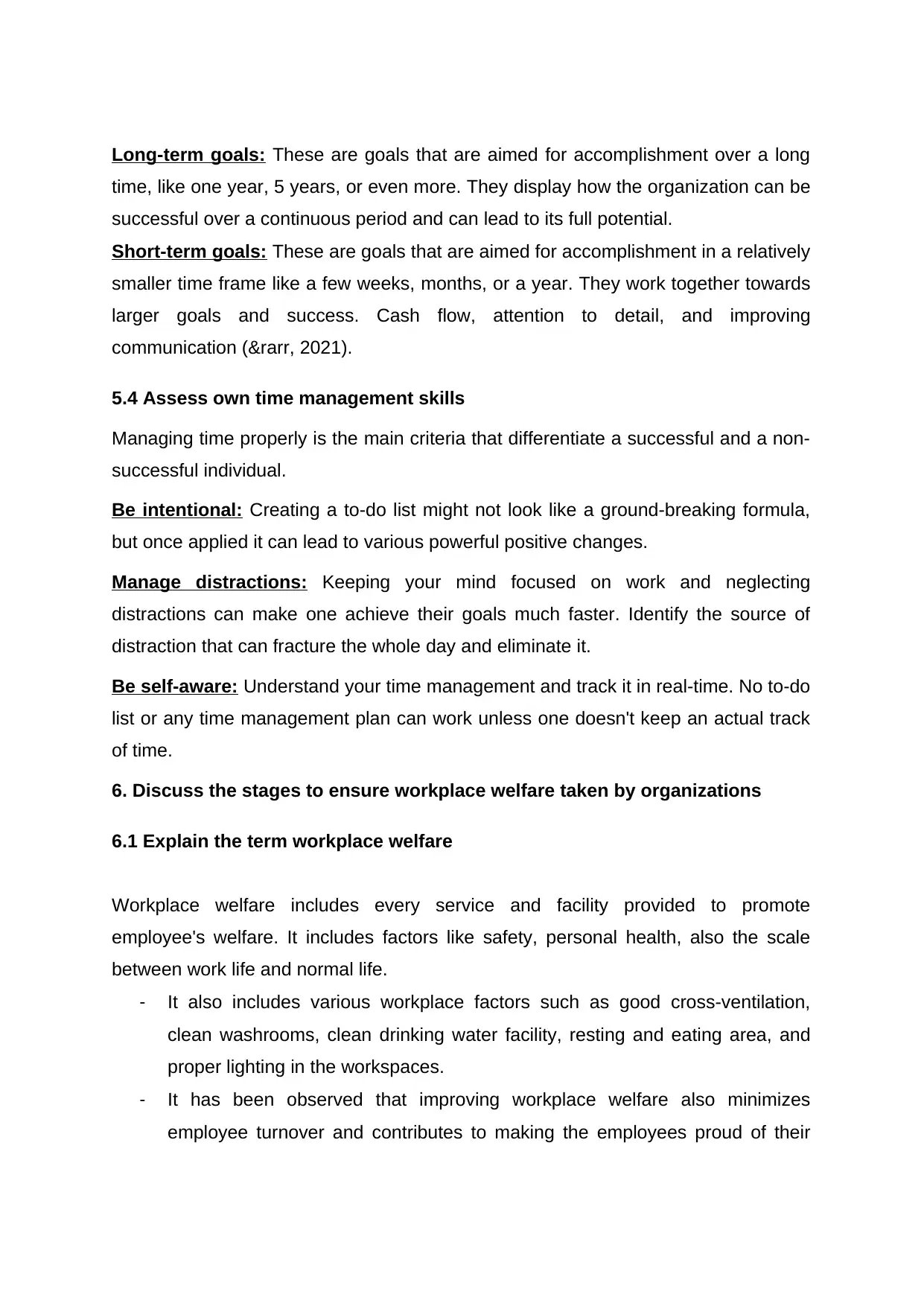
Long-term goals: These are goals that are aimed for accomplishment over a long
time, like one year, 5 years, or even more. They display how the organization can be
successful over a continuous period and can lead to its full potential.
Short-term goals: These are goals that are aimed for accomplishment in a relatively
smaller time frame like a few weeks, months, or a year. They work together towards
larger goals and success. Cash flow, attention to detail, and improving
communication (&rarr, 2021).
5.4 Assess own time management skills
Managing time properly is the main criteria that differentiate a successful and a non-
successful individual.
Be intentional: Creating a to-do list might not look like a ground-breaking formula,
but once applied it can lead to various powerful positive changes.
Manage distractions: Keeping your mind focused on work and neglecting
distractions can make one achieve their goals much faster. Identify the source of
distraction that can fracture the whole day and eliminate it.
Be self-aware: Understand your time management and track it in real-time. No to-do
list or any time management plan can work unless one doesn't keep an actual track
of time.
6. Discuss the stages to ensure workplace welfare taken by organizations
6.1 Explain the term workplace welfare
Workplace welfare includes every service and facility provided to promote
employee's welfare. It includes factors like safety, personal health, also the scale
between work life and normal life.
- It also includes various workplace factors such as good cross-ventilation,
clean washrooms, clean drinking water facility, resting and eating area, and
proper lighting in the workspaces.
- It has been observed that improving workplace welfare also minimizes
employee turnover and contributes to making the employees proud of their
time, like one year, 5 years, or even more. They display how the organization can be
successful over a continuous period and can lead to its full potential.
Short-term goals: These are goals that are aimed for accomplishment in a relatively
smaller time frame like a few weeks, months, or a year. They work together towards
larger goals and success. Cash flow, attention to detail, and improving
communication (&rarr, 2021).
5.4 Assess own time management skills
Managing time properly is the main criteria that differentiate a successful and a non-
successful individual.
Be intentional: Creating a to-do list might not look like a ground-breaking formula,
but once applied it can lead to various powerful positive changes.
Manage distractions: Keeping your mind focused on work and neglecting
distractions can make one achieve their goals much faster. Identify the source of
distraction that can fracture the whole day and eliminate it.
Be self-aware: Understand your time management and track it in real-time. No to-do
list or any time management plan can work unless one doesn't keep an actual track
of time.
6. Discuss the stages to ensure workplace welfare taken by organizations
6.1 Explain the term workplace welfare
Workplace welfare includes every service and facility provided to promote
employee's welfare. It includes factors like safety, personal health, also the scale
between work life and normal life.
- It also includes various workplace factors such as good cross-ventilation,
clean washrooms, clean drinking water facility, resting and eating area, and
proper lighting in the workspaces.
- It has been observed that improving workplace welfare also minimizes
employee turnover and contributes to making the employees proud of their

work and the organization (Welfare Facilities at Work - Adequate welfare
facilities should be provided for people at work - Quest Cover, 2021).
6.2 Discuss the health & safety duties of employers’ and employees’
Health & safety duties of the Employer's
- The employer has the 'duty of care for making sure that employee's health,
safety, and welfare are taken care of while they're at work.
- They must start with a risk analysation to identify health and safety hazards.
- Ensure proper ventilation, comfortable and breable temperature, sufficient
vision from lighting, clean washrooms, and restrooms all meet health and
hygiene and safety requirements.
- Informing about capable hazards at the workplace they do - chemicals used
by the organization provide data, rules and regulations, training as needed.
(SaiKiran, B. 2013)
Employee's health & safety responsibilities
- Report any injury, strain, or sickness they suffer as a result of performing the
job, the employer might need to switch the way you work.
- Making sure they do not manhandle or misuse things that have been provided
to them for health, safety, or welfare.
- Take proper care not to put other acquaintances and public members at risk
through work.
6.3 Discuss the factors by which enterprise can reduce the emergenece of
work associated stress
Stress in employees can interfere with their productivity and performance, it can also
disturb physical and emotional health (Murphy J, 2021).
facilities should be provided for people at work - Quest Cover, 2021).
6.2 Discuss the health & safety duties of employers’ and employees’
Health & safety duties of the Employer's
- The employer has the 'duty of care for making sure that employee's health,
safety, and welfare are taken care of while they're at work.
- They must start with a risk analysation to identify health and safety hazards.
- Ensure proper ventilation, comfortable and breable temperature, sufficient
vision from lighting, clean washrooms, and restrooms all meet health and
hygiene and safety requirements.
- Informing about capable hazards at the workplace they do - chemicals used
by the organization provide data, rules and regulations, training as needed.
(SaiKiran, B. 2013)
Employee's health & safety responsibilities
- Report any injury, strain, or sickness they suffer as a result of performing the
job, the employer might need to switch the way you work.
- Making sure they do not manhandle or misuse things that have been provided
to them for health, safety, or welfare.
- Take proper care not to put other acquaintances and public members at risk
through work.
6.3 Discuss the factors by which enterprise can reduce the emergenece of
work associated stress
Stress in employees can interfere with their productivity and performance, it can also
disturb physical and emotional health (Murphy J, 2021).
⊘ This is a preview!⊘
Do you want full access?
Subscribe today to unlock all pages.

Trusted by 1+ million students worldwide
1 out of 16
Related Documents
Your All-in-One AI-Powered Toolkit for Academic Success.
+13062052269
info@desklib.com
Available 24*7 on WhatsApp / Email
![[object Object]](/_next/static/media/star-bottom.7253800d.svg)
Unlock your academic potential
Copyright © 2020–2025 A2Z Services. All Rights Reserved. Developed and managed by ZUCOL.





